Home » Other Articles » Tuesday Treasures Index » Tuesday Treasures - November 2022 - Tuesday Treasures - November 2022
Tuesday Treasures - November 2022

TUESDAY 29 NOVEMBER
GWR Instructions to Passenger Guards, 1874
Over 148 years ago, our railways, including the Great Western, operated in a completely different social and transport environment. Our Blog today uses a GWR staff circular of 1874 from the Great Western Trust collection that surely highlights the extent of the change from ‘then to now’.
To set the scene, before the current age of texts, phone, emails etc, the only formal means of recording important instructions to staff, and do so in such a way that those staff could not deny their existence, was the hard copy, printed ‘Circular’.
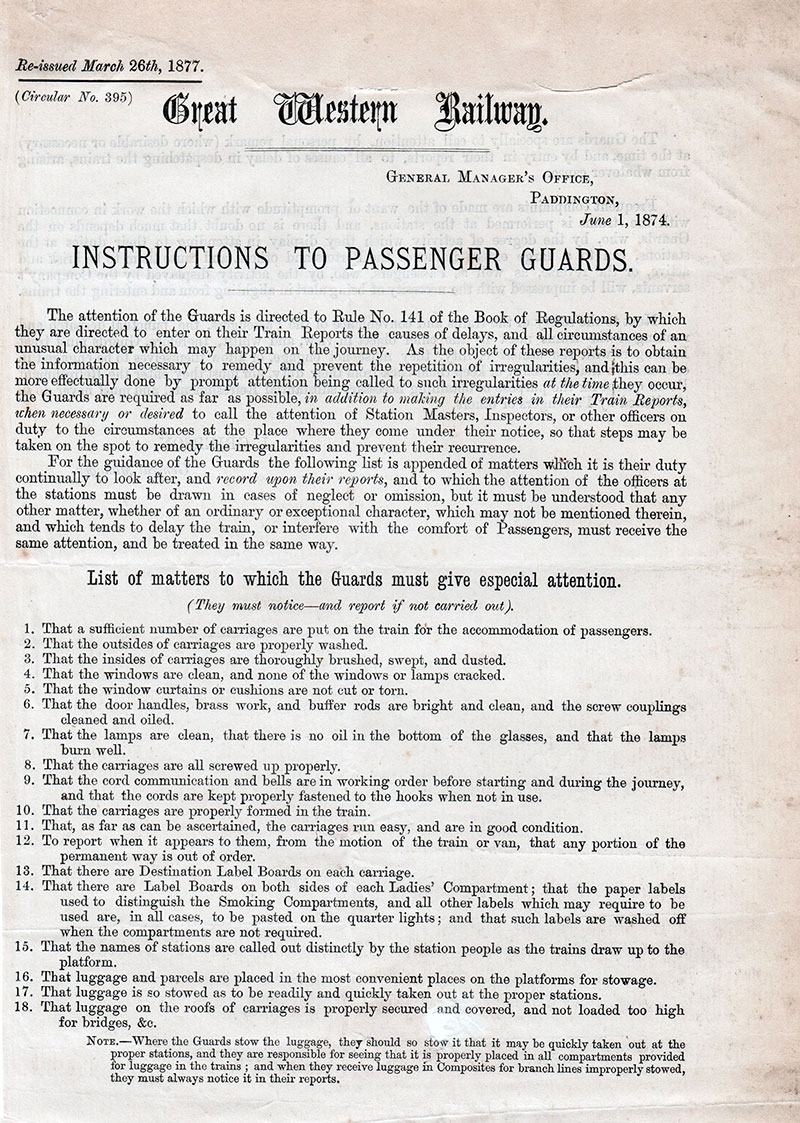
Produced under the authority of the various Heads of Departments the highest rank one being from the General Manager, the Superintendent of the Line (recall last week’s Blog?) was next in rank, followed by Divisional officers and Departmental heads. Each such Notice or Circular in this case, was sent to every, yes every relevant station and location, to be duly noted by the principal staff member there and pasted by a clerk into what were called ‘Guard Books’, effectively very large, bound ledgers with blank sheets to which each Circular was pasted. Then the principal staff member had to ensure all relevant employees under them had read the content, so he (yes he) could confirm back up the management chain, that the content was noted and would be acted upon. Any subsequent failure to comply was a disciplinary offence!
This whole process went back to the very first days of the GWR (more later) but this Circular was issued by the General Manager, one James Grierson, who was in fact the first such appointee to that role, and was remarkably young, aged only 36 but acknowledged as an outstandingly able manager even then, having been the youngest Chief Goods Manager beforehand.
So to the Circular itself. Within the 18 individual tasks, which were identified as those to be given special attention, so plenty more were below this level, we see the standard provision of Ladies only compartments (identified on both sides of each compartment, to avoid a male blundering in unawares), and luggage stored on the carriage roofs!
The Circular goes on to remind Guards that they must treat passengers with ‘the utmost civility’ (the GWR's very first Notice to Staff of 18 July 1838, was on that very same subject!) but whilst properly engaging with passengers, they must not allow it to delay the train or distract them or ‘keep them back from their duty’.
Our last observation is based upon human foibles. This circular though dated 1874 was over-printed that it was reissued on 26 March 1877. Undoubtedly the General Manager found it necessary to remind Guards of all these duties only 3 years later!
Today’s ‘Train Managers’ have much to do of course, but at least they avoid dealing with luggage on the roof!!
TUESDAY 22 NOVEMBER
When Coinage and Cash Mattered
Our current age has almost overnight moved to credit and debit cards with ‘contactless payment’ and internet banking. Many organisations simply do not deal in coinage or bank notes any more, and for those of us of a certain age, it is dismaying to find framed mint sets of UK bank notes and the associated coinage, on sale for collectors and as mementos of a passing age.
If we try however hard, to overlook the staggering degree of inflation since the birth of the GWR, such that we might think a 12.5 modern pence equivalent price of two shillings and six old pennies for a meal on a train was cheap, today’s blog reflects on a fact that hasn’t changed at all!

From the Great Western Trust collection we illustrate a very simple but telling internal notice to Great Western Railway staff in April 1913 from their operating chief, the Superintendent of the Line, then one Charles Aldington. Pause to ponder that very distinctive senior staff title!
Entitled ‘BASE COINS’ it points to two very valuable coins of those days, the Half-Crown was two shillings and sixpence, (12.5p in today’s coinage and £11.39 at today’s value with inflation between 1913 and 2022) and eight half-crowns amounted to one UK Pound Sterling. A Florin was the recognised popular name for a two shilling piece (10p in today’s coinage and £9.11 at today’s value allowing for inflation), of which ten would amount to one UK Pound Sterling.
The Florin, introduced in 1849, was an early attempt to decimalise the currency. We have illustrated an early Florin, rather worn, from the reign of Queen Victoria, that emphasises its decimal credentials with the statement that it is worth one tenth of a pound. The coin is 30mm in diameter.

The phrase ‘Base Coins’ was the description then used for what we might call counterfeit coins, minted by fraudsters to avoid paying in legal tender as it were. The name goes back to the medieval alchemists who wasted much time trying to turn base metals, such as lead, tin, iron and copper, into gold.
The railways alone, received vast daily sums in tendered coinage, and therefore any amount of illegal coins would impact their income, and worse, they would be legally at risk, if such coins were returned as the daily ‘petty cash’ to the stations and offices, for re-use by staff dealing with the public!
It is worth noting that in the vast bureaucracy of running so many stations etc, the GWR Audit Department had a great number of stringent procedures for dealing with the cash obtained every day. One illuminating fact was that each station sent to its ‘head district station or office’ its takings in a cash bag or cash safe by a defined train every day. The receiving office would of course check every such amount for correctness and for base coins, and use as much as possible of the cash (not bank-notes) therein, as a return of the set amount of working or ‘petty cash’ each station needed for the next day. Why so? Well, even the GWR were then wise to the rate of bank charges for them counting and dealing with tendered coinage, so the GWR worked to minimise the amounts the banks dealt with!
With our current plastic card and internet money transactions, the anxiety we have has now moved from base coins to internet fraud, although even now, some foreign coins still in circulation, are too easily mistaken for our own!
TUESDAY 15 NOVEMBER
The World War 2 Railways - Facts About British Railways
With the 11th November Remembrance Day just passed, and having previously blogged on the subject of the vital contribution of the GWR’s Home Guard, which on the UK wide scale was part of the rather fondly called ‘Dad’s Army’, in this blog we turn to a remarkable booklet published by the British Railways Press Office in April 1940 by all the Big 4 Railways, then under government control.
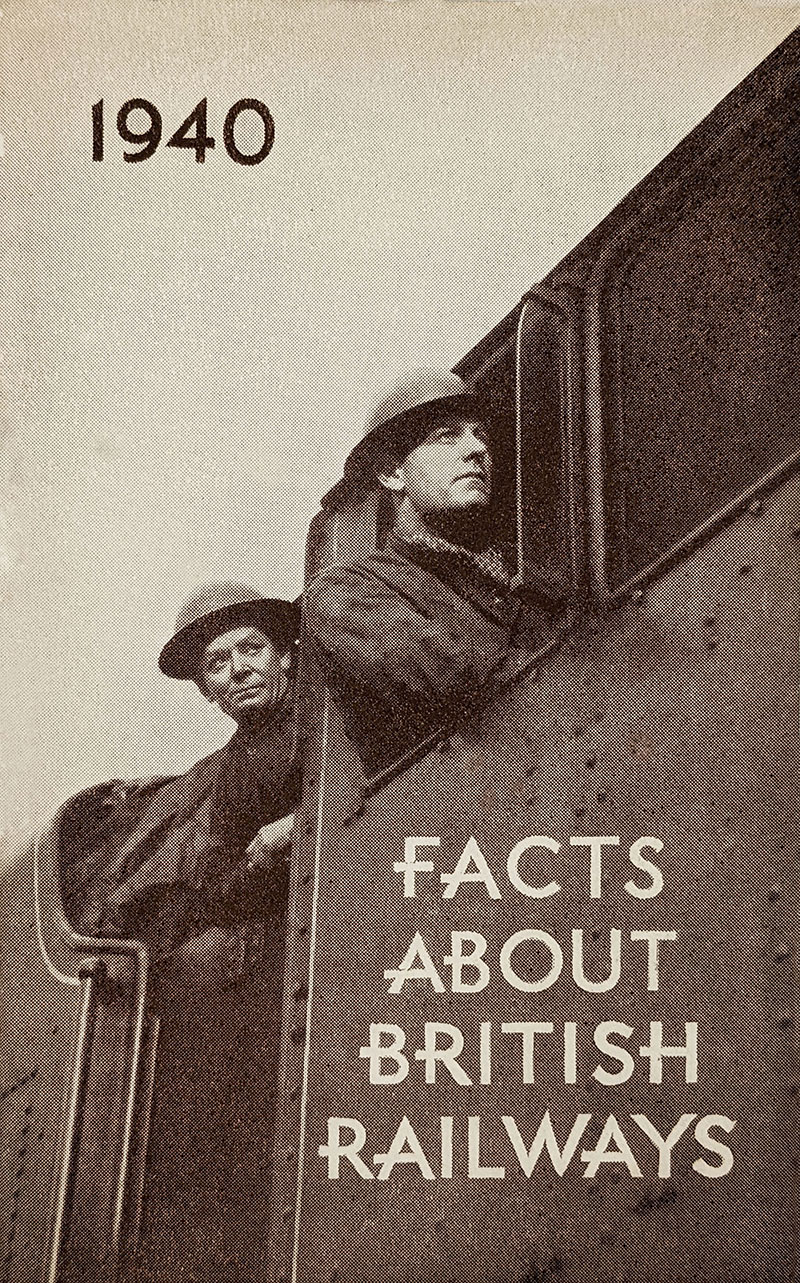
This booklet and its title, was in fact, a wartime continuation of a series issued annually, our earliest undated example from the Great Western Trust collection is circa 1926, and it ran from then, through the war years, with our latest version being 1977 but possibly it ran later.
Given that the pre and post war editions concentrated upon the range of data that covered both the physical extent of the railway company’s undertakings and the services offered, the wartime editions naturally concentrated upon their vital wartime activities. Perhaps a little surprising given that our ‘enemy’ could be reminded, if it needed it, just how vital our railways were to winning the war although frankly in 1940, it was more a case of allowing the UK to survive the onslaught.
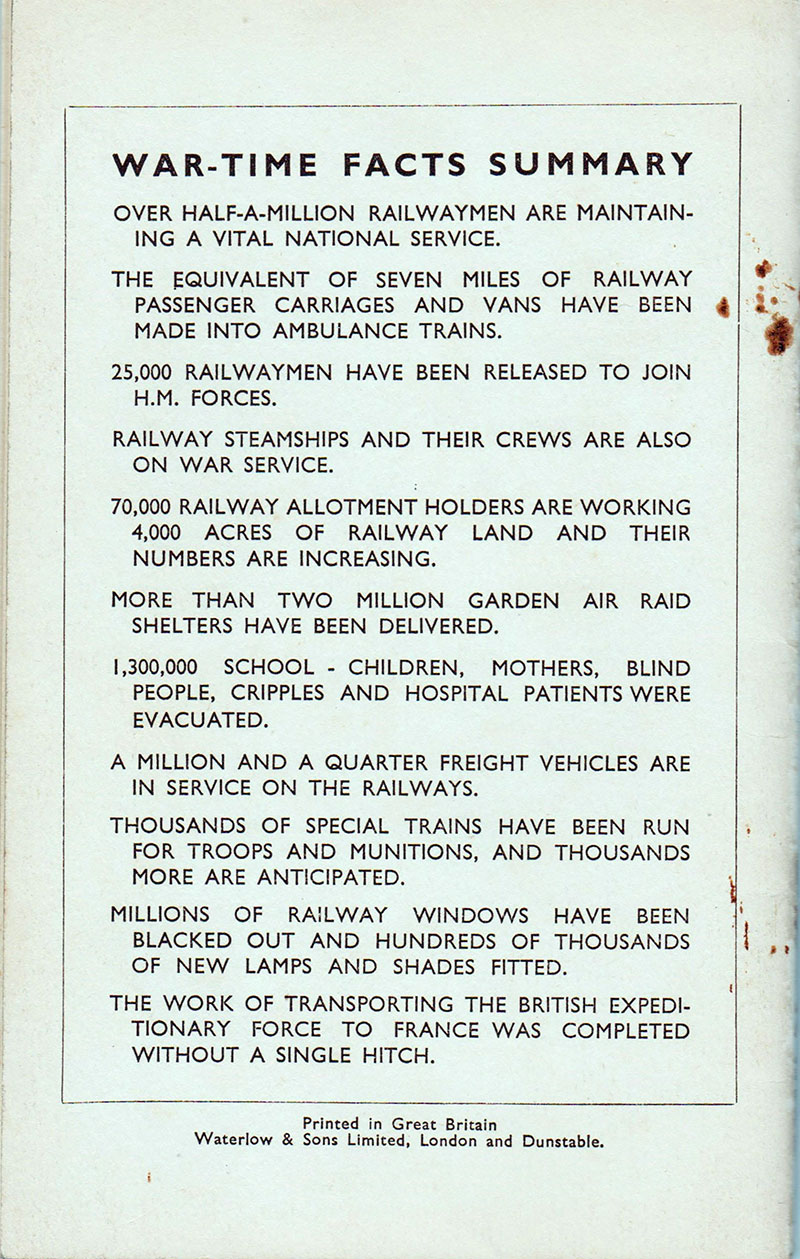
We illustrate both the striking front and back covers. The front with an LMS loco and footplatemen, each with their standard issue metal helmets, probably rarely worn whilst driving. The very informative back cover summarises the startling statistics that were thought most relevant to a very hard pressed and fearful populous.
What is even more illuminating, is that it isn’t a trivial publication, but it has 32 very informative pages covering government controls, key staff, and a mass of relevant wider information even the financial results for each year from 1929 to 1939. From our GWR perspective, it is important to record that the foreword was written by Sir James Milne, the GWR’s General Manager, and at that time, Chairman of the General Managers’ Conference of 1940. Perhaps the most appropriate extract is his final paragraph:-
“The facts given in this booklet will afford some indication of the vast resources which have been willingly placed at the disposal of the country in order to assist in the successful prosecution of the war”.
We who have long benefited from that contribution of the then privately owned and operated railways to the successful outcome of the war, must always pause, give thanks and reflect upon how vital and selfless that was.
TUESDAY 8 NOVEMBER
Railways as Common Carriers
When Parliament granted legal status to an application to become a railway company, by considering a Bill that then if approved became an Act of Parliament, it did so but with strong obligations on that new entity. In exchange we might say, for granting it statutory powers to acquire private owner’s land on which to build its lines and stations etc, it had to become a ‘common carrier’.
‘Common’ in that legal application, actually meant that it had to offer a transport service for whatever goods it might be asked to carry, and to do so at published rates.
What seemed a perfectly justified and manageable obligation in early Victorian era, where the railways certainly transformed the speed and volume of goods transported, mostly at much reduced costs to the customers and with less damage in transit, became in later times, beginning after WW1, an increasing liability when road transport could ‘cherry pick’ much traffic that was cheaper to send by road.

The post-1921 grouping into four main railway companies, GWR, LNER, LMS and SR, may have reduced the gross extent of the damaging inter-company rivalry for goods traffic, but the continued threat from independent road transport was only increasing. So, at long last, those ‘Big 4’ railway companies began to co-operate, not least in publications and joint service provision.
The leaflet we illustrate today (front and back), comes from our extensive publicity archive held by the Great Western Trust. It strikingly shows that even by the closing years of the private railway companies, their ‘common carrier’ obligations could indeed require them to transport the array of items in the designed leaflet. Quite how a heavy grass roller (much used on cricket pitches) was secured away from an expensive bicycle and wooden dog kennel, we leave to the railway goods staff to ponder!
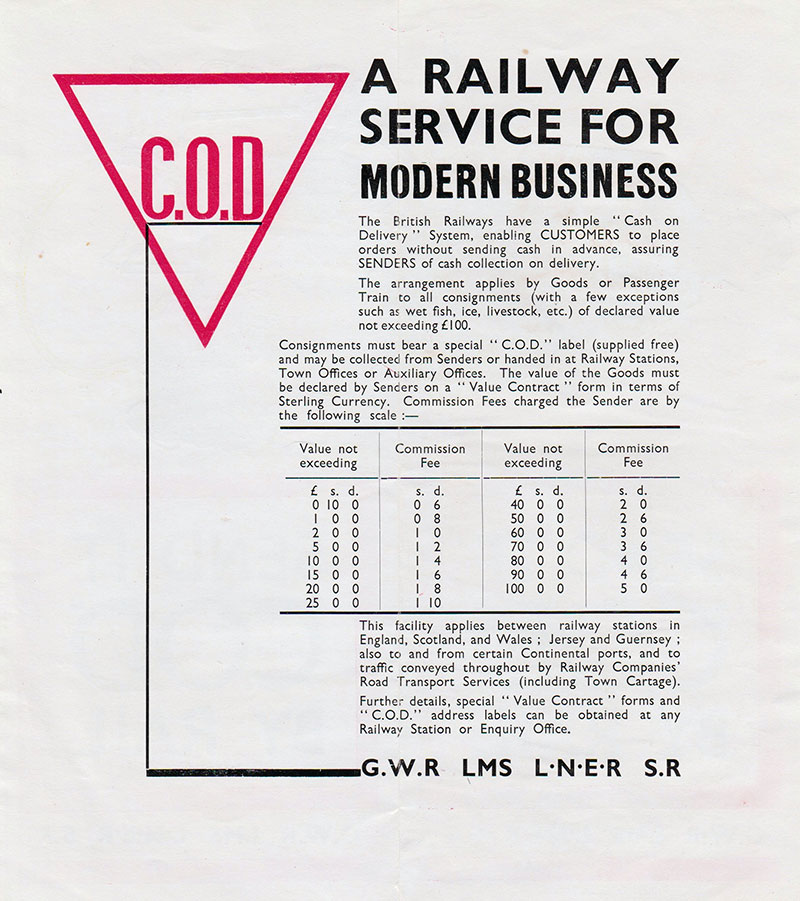
Keen eyed readers will notice that the text includes ‘The British Railways’ as descriptor of those Big 4 companies, and maybe predicts the future title of the post war, nationalised railways?
Our ‘white van’ dominated goods delivery environment of today, is a far cry from the times of our parents and grandparents when a local railway station or goods depot would call to advise on the arrival of an important family item. Of course COD meant Cash on Delivery, as opposed to the larger regular goods customers such as industrial manufacturers or shops, who had special accounts with the railway companies and were billed by different means.
TUESDAY 1 NOVEMBER
Holidays by Train – Part 8
As the self-proclaimed ‘Holiday Line’ our blogs have many items from the Great Western Trust collection to show how much the Great Western Railway pushed this theme in its publications of all kinds. It is hardly surprising that the nationalised BR Western Region followed in those established footsteps and today's blog goes so far as to show how the ‘Holiday’ theme, could be as long or in this case as short as you liked, so long as you travelled by rail!
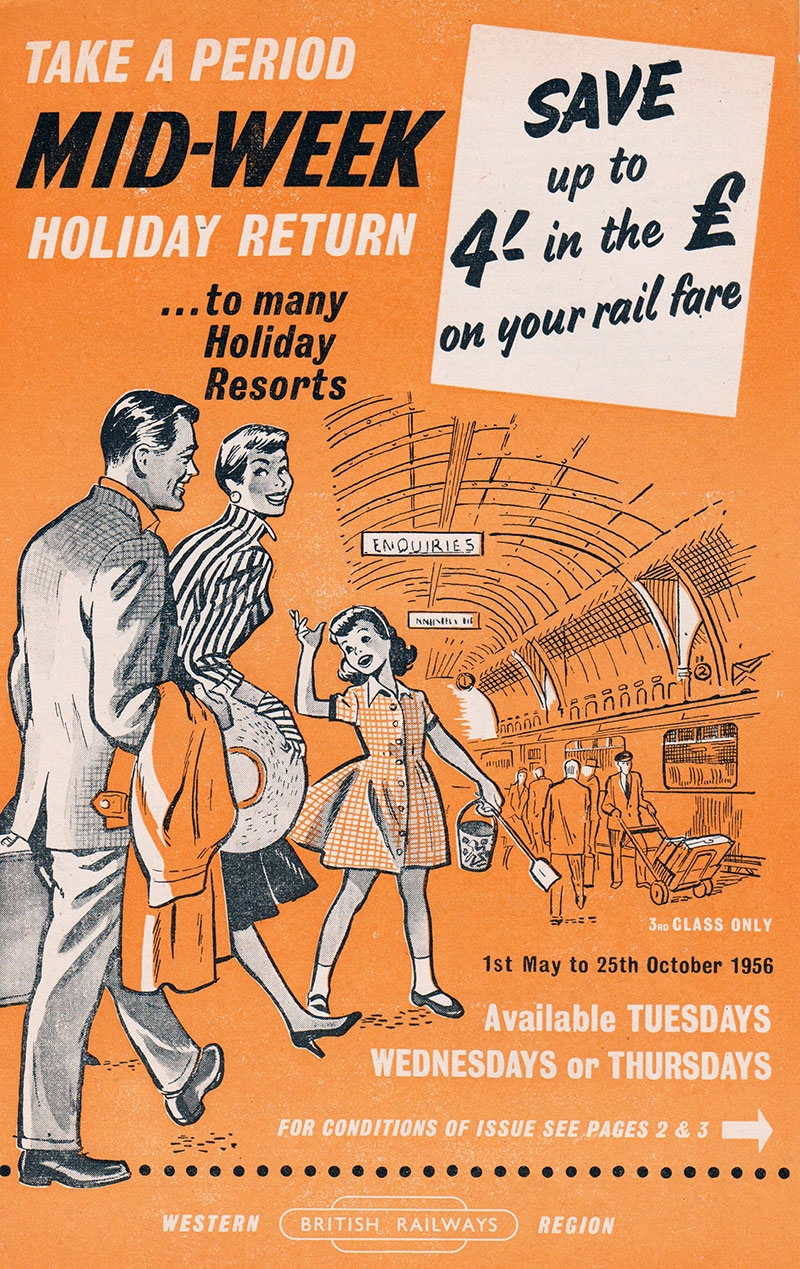
The two pamphlet covers illustrated, demonstrated another ‘Holiday’ established in the mid and late 50s and early sixties, the mid-week one. What is also pretty obvious is that the enticement by way of ticket price reduction, increased between 1956 and 1961 from 4 shillings in the pound to 5 shillings (20 pence up to 25 pence of today's currency).
The additional interest in these pamphlets of course is their contemporary period designs. That of 1956 has the by then idealised family, Dad with shiny hair and in a suit of course, Mum in a striking striped top and high heels, and their daughter already with her bucket and spade in the outfit so many folk of a certain age will recall of their childhood. That of 1961 is altogether simpler, and however crude the sketch of the train is, a clever combination of train and the Pound symbol designed as its track.
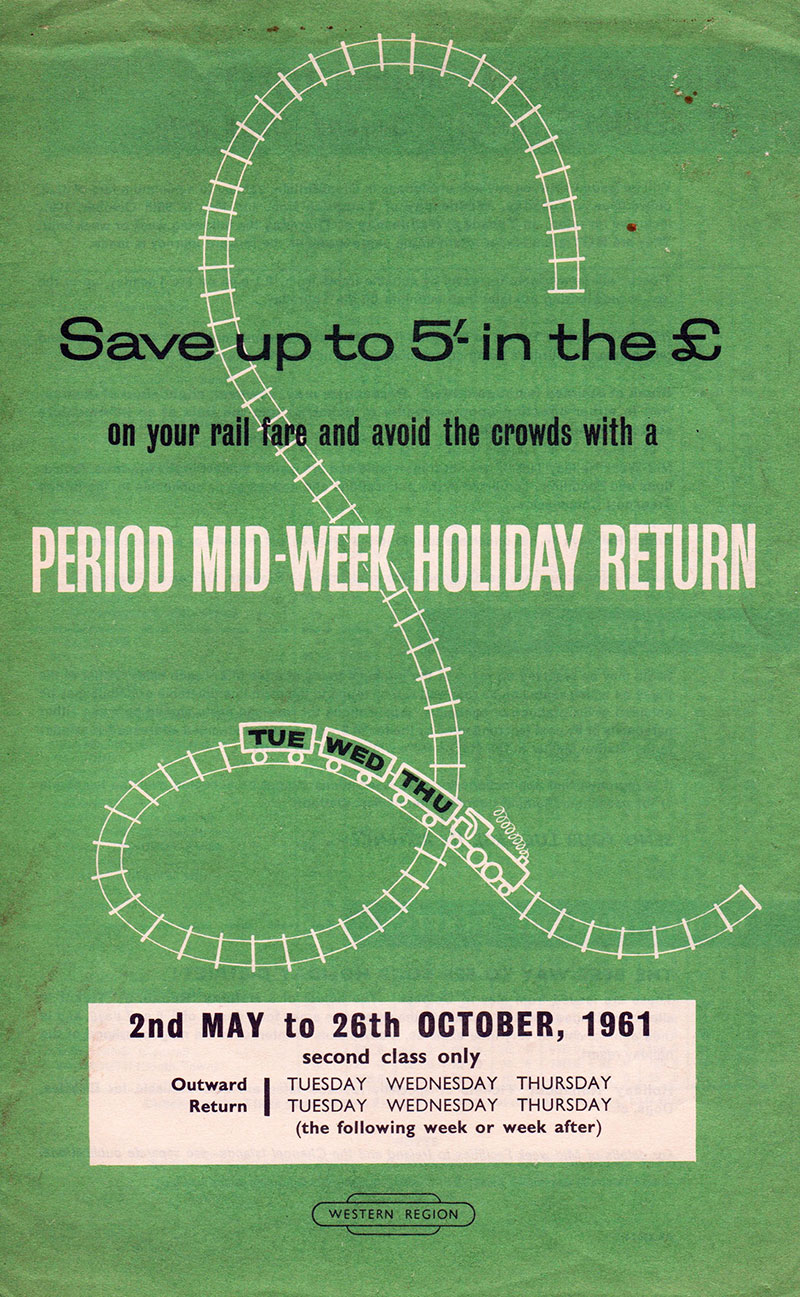
On both pamphlets, the information provided is comprehensive including examples of return fares from a host of stations. The 1956 version refers to 3rd class as the only tickets being available, which was overtaken by events because 3rd class was replaced by 2nd class on 2 June that year.
Happy that such ephemeral items have survived beyond their year of application, we are able to reflect upon vastly changed times and advertising styles, hardly surprising after 60 or more years maybe, but the Great Western Trust collection has countless examples of that change of transport realities and of course our evolving social history.
 |
 |
 |
 |
Didcot Railway Centre Newsletter
Stay up to date with events and what's going on at Didcot Railway Centre.
You may unsubscribe at any time. We do not share your data with 3rd parties.